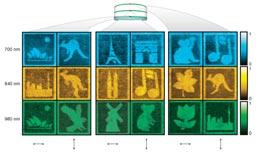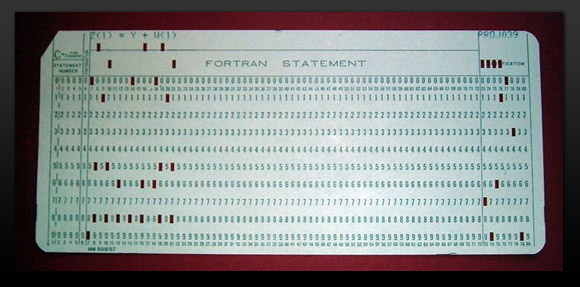 DVDs are set to explore new dimensions.Punchstock
DVDs are set to explore new dimensions.PunchstockPosted on 05/23/2009 1:35:38 PM PDT by neverdem
 DVDs are set to explore new dimensions.Punchstock
DVDs are set to explore new dimensions.PunchstockSpreading into extra dimensions could help next-generation DVDs to store even more data than they currently do. The new technique could squeeze around 140 times the capacity of the best Blu-rays into a standard-sized disk.
Traditional DVDs and Blu-ray disks store data in two dimensions, and there's been a recent push to increase their capacity by creating multi-layered disks that store data across three dimensions. But, asks James Chon at the Swinburne University of Technology in Melbourne, Australia, why stop there?
Chon and his colleagues are stepping into hyperspace, by encoding information in two new dimensions — the wavelength and polarization of the laser light used to write the data. The key for his team was to find a material for the disk that could store this extra information. "When my colleague Min Gu first suggested the idea, he had no idea if such a material existed," says Chon. "Luckily, my background is nanoparticles, and I knew of the perfect fit."
“Luckily, my background is nanoparticles, and I knew of the perfect fit.”
James Chon
Swinburne University of Technology
That ideal material contains gold, rod-shaped nanoparticles of different sizes and orientations. When polarized light, such as that emitted from a laser, is fired onto this material, it 'melts' only the rods whose orientation matches the direction of polarization, causing them to become spherical. "Polarized light only 'sees' and records on a subset of the nanorods," explains Chon. "Change the polarization and you can record on the same volume as though it is a whole new recording medium."
Gold nanorods are also sensitive to the colour of the laser. Different wavelengths melt rods with particular length-to-width ratios. "Depending on the number of polarizations and colours of light you use, you have a number of different channels to record on," says Chon. His team have demonstrated that using two polarizations and three colours, you can pack around 140 gigabytes of information into each cubic centimetre of disk space. That allows a DVD-sized disk to hold 1.6 terabytes of data. A Blu-ray, by comparison, can store around 50 gigabytes. Adding an extra dimension by using another polarization could ramp that up further to 7.2 terabytes.
Exploiting added dimensions will also provide a new way to encrypt data, says Chon. "You can store, say, ten different patterns on the same volume of disk, and only the people who know the correct wavelength and polarization will be able to pick out the right pattern to read."
"The work is unique and highly innovative," says Hisayuki Yamatsu, at the Advanced Optical Systems Laboratory near Tokyo, Japan. "It shows a new approach to realize optical memory with much higher recording density than that of the current optical disks."
 Click for a larger image.Nature
Click for a larger image.Nature
Yamatsu is also impressed by the team's method of reading data, using a high-intensity, but low-energy laser, which doesn't melt the nanorods. Gold nanorods respond much more efficiently than spherical nanoparticles to low-energy lasers — a phenomenon that has been dubbed the 'lightning rod effect'. So the team used a low-energy laser to scan the surface and see which areas have been melted and which haven't, thereby reading the data.
The advantage of using a low-energy laser is that it won't accidentally interfere with data recorded on surface layers while reading from deeper layers. "For multi-layer recording, how to reduce inter-layer crosstalk is a vital issue," says Yamatsu.
“This is the first time that anyone has discussed so many ways to store information in the same volume at the same time.”
Tom Milster
University of Arizona
Tom Milster, an optical physicist at the University of Arizona in Tucson, also likes the work. "This is the first time that anyone has discussed so many ways to store information in the same volume at the same time," he says. But, he adds, it may be tough to read the disk quickly because the information is packed so densely. "I'm a big fan of the work, but this could be a major technological hurdle for them," Milster says.
Yamatsu is also concerned that the team read and write data using femto-second lasers, which are expensive and bulky. "It is almost impossible to implement a femto-second laser to a commercial-based drive system," he says.
Chon agrees that this is an obstacle. "We are relying on the laser community to come up with a more practical solution," he says. Chon says that the team could have a prototype disk ready within five years and see their "technology flourishing between 2015 and 2025".
"But for now," Chon adds, "we have at least shown that the material for five-dimensional optics is out there."
Superdiamonds!
I’m one of the few people I know without a DVD/Blueray player.
I don’t want to be caught in the old VHS/Beta thing. As soon as I buy one the other will become the standard. I’ll wait until the battle is overt.
Thanks for the post. I enjoy reading scientific related articles.
What I see here is not so much the idea that more data could be packed on a standard DVD sized disk, although of course that could be done, but the promise of mini disks that could hold entire movies. It would seem that a one inch or even possibly a considerably smaller disk, could hold an entire movie.
It also seems that if you could get it small enough, perhaps a spinning disk would not be required. Perhaps a tiny wafer could be inserted in the side of a television or viewer, and a laser bounced off a mirror might be able to do the reading off a stationary medium.
This is fertile ground for thought.
Thanks.
I use DVD’s to store data. 4.7 gigs sometimes isn’t enough. Vacation photos can sometimes exceed 8 gigs. A weekend of photos can hit 4 gigs easy. I’m uneasy storing my photos on an external hard drive. I’ve already lost several thousand when externals decide to kick the bucket.
I want to travel forward and backward in time at my choosing. So, when does this hit the market because I'm tired of the Zero Admin.
France Defies its Heritage to Condemn Alcohol
Old seasonal flu antibodies target swine flu virus
Genetic analysis of swine flu virus released
FReepmail me if you want on or off my health and science ping list.
But I imagine DVD’s are susceptible to the same thing that happens to CD’s... some kind of fungus can eventually start degrading them.
See the first link in comment# 8.
I keep them in a plastic bag with silicon gel packs. Eventuality I’ll have to transfer them over to new “whatever” storage they’ll have out in a few years.
Bookmarked.
Good plan. Most important, don’t scratch them in the least. And I’m not sure, but I would keep them away from any UV light also.
"Show me just what Mohammed brought that was new, and there you will find things only evil and inhuman, such as his command to spread by the sword the faith he preached." - Manuel II Palelologus
Fascinating, and thanks for the ping. Can you please add me to your science/tech ping list?
"Nanorod" used to be a insult. Hmmm.
Somebody told me to look up archival quality gold cd's and dvd's for storage of my most important data. They are supposed to be guaranteed for 100 years or something but are quite pricey and I haven't heard much input from anyone who has tried them.
Anyway, I tend to make complete new backup copies of my crucial stuff once every year or two, so maybe I'll be OK.

I actually still have several boxes of those from my college days.
Those are problem for me, as I don’t have an iron.
Disclaimer: Opinions posted on Free Republic are those of the individual posters and do not necessarily represent the opinion of Free Republic or its management. All materials posted herein are protected by copyright law and the exemption for fair use of copyrighted works.